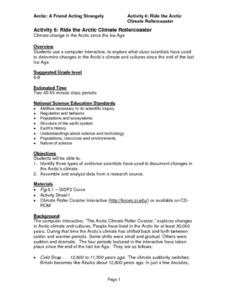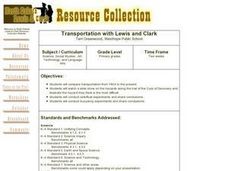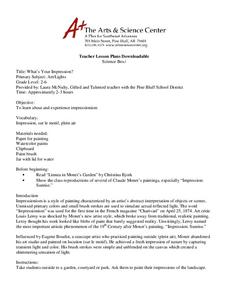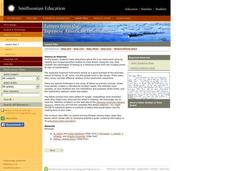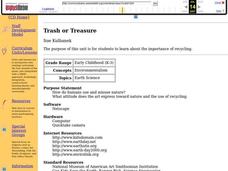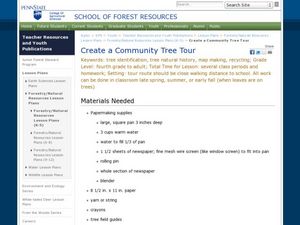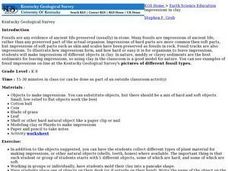Curated OER
What did T. rex taste like?
Students examine the three domains of life and explain that all living things share a common ancestor. In this paleontology lesson plan students are introduced to the process of illustrating evolutionary relationships.
Curated OER
The Little Transistor That Could
Middle schoolers explore the nature of technology through the history of the transistor. They examine how the engineers at the Bell Labs used knowledge of science and technology, together with strategies of design, to solve practical...
Curated OER
Eyewitnesses to Change
Students explore recent changes in the Artic's climate that have been observed by Artic residents. They watch videos, take notes and create a concept map. They also look at historical weather data from a specific Artic community. The...
Curated OER
Ride the Arctic Climate Rollercoaster
Students view interactive CD-ROM entitled The Arctic Climate Roller Coaster, research evidence of changes in climate through the years, record ways people responded to changes, and create short presentations to share evidence with...
Curated OER
Financial Planning for Catastrophe
Students examine the case of The Gulf Coast and relate it financial importance. In this financial planning instructional activity, students watch a video and then begin to analyze how to plan for the unexpected by reviewing the financial...
Curated OER
Native American Storytelling
Eleventh graders examine the background of Native American myths and legends. In this American History activity, 11th graders read a myth out loud to their classmates. Students compare and contrast their myths with other...
Curated OER
Depicting Women and Class in a Global Society
Students analyze the evolution of women's work from the 19th century to present day and create artwork depicting women. In this women's roles lesson, students compare and contrast the use of space and color in the two paintings depicting...
Curated OER
Turn of the Century
Students explore the transformation of America's economy in response to the Industrial Revolution in terms of patterns of agricultural and industrial development relating to climate, natural resource use, markets and trade.
Curated OER
Making Rose Petal Beads
Pupils make homemade beads from flower petals while exploring Native American history, culture, and art.
Curated OER
Celebration and Satire
Students compare and contrast different perspectives of the French Revolution. In this visual arts instructional activity, students discuss the use of satire and caricature in history and create satirical cartoons based on contemporary...
Curated OER
The "Write Sport"
Fifth graders discuss the history of sports in Iowa. In this sports lesson plan, 5th graders write a friendly sports letter and a how to directional writing. They write five entries in their journal from the point of view of a piece of...
Curated OER
Time and Cycles - Dendrochronology
Middle schoolers investigate the lives of trees by examining ring cycles. In this plant life instructional activity, students identify the field of study known as dendrochronology and discover its history. Middle schoolers...
Curated OER
Pseudogene Suite
High schoolers use Biology Workbench to explore DNA sequence data for the GULOP gene in humans, chimpanzees, orangutans, and crab-eating macaques and the beta globin gene and its pseduogene in humans, gorillas, and chimpanzees.
Curated OER
Transportation with Lewis and Clark
Students listen to a PowerPoint presentation and complete a Venn diagram comparing the methods of transportation in the early 1800s with today's transportation. They experiment with the buoyancy of keelboats.
Curated OER
Water - Planning for the Future
Students explore and examine the increases and/or decreases for water user groups: irrigation, municipal, manufacturing, steam electric power generation cooling, livestock, and mining. They utilize percentage changes during their...
Curated OER
What's Your Impression?
Students paint landscapes. In this Impressionism lesson, students explore the history behind the Impressionist Movement in art and paint their own impressionist piece inspired by a nearby landscape.
Curated OER
Letters from the Japanese American Internment
Students examine letters of Japanese-American children during internment in World War II. They discover what it was like in the camps and how they were treated once they were released. They also view photographs of the camps.
Curated OER
Fort Clatsop: The Corps of Discovery's Winter at Fort Clatsop
Students investigate the Lewis and Clark expedition and how it helped to shape American expansion during its early history. Students reflect upon the period of history and its implications for America.
Curated OER
Blooming Thermometers
High schoolers study phenology, or the study of climate change. They research the Japanese springtime festival of Hanami and plot and interpret average cherry blossom bloom date data from the past 1100 years.
Curated OER
Trash or Treasure
Students explore the importance of recycling. Students are read "Can Kids Save the Earth", they are then guided in a recycling project. Students discuss Earth Day, and make poster to promote Earth Day.
Curated OER
Dig Into Ireland
Learners study Ireland and its distinctive culture. For this exploring Ireland lesson students view a program on Ireland, answer questions then divide into groups and research the Irish connection.
Curated OER
Create a Community Tree Tour
Students study tree identification. In this tree identification lesson, students design and assemble a tree tour booklet describing 5 trees found in their community. The booklet should feature common and Latin names of the species, a...
Curated OER
Predicting: Making a Hypothesis
Learners analyze information from various sources to create a hypothesis about the origin of a family artifact. Students create a hypothesis about the origin of the item and write a paragraph explaining why they believe the hypothesis is...
Curated OER
Impressions in Clay
Students examine how fossils are created. They make impressions of different objects in clay and compare them to examples of fossils.





